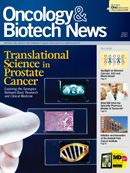Publication
Article
Oncology & Biotech News
Roswell Park Cancer Institute: A History of Initiative and Innovation
Author(s):
Founded in 1898 by Dr Roswell Park, Roswell Park Cancer Institute (RPCI) is the oldest dedicated comprehensive cancer center in the country
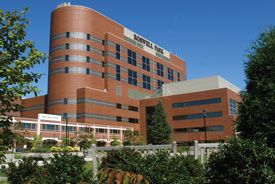
Founded in 1898 by Dr Roswell Park, Roswell Park Cancer Institute (RPCI) is the oldest dedicated comprehensive cancer center in the country. In 1974, the Buffalo, New York, facility was 1 of the first 3 institutions to be National Cancer Institute (NCI)-designated as a comprehensive cancer center.
“Roswell Park [Cancer Institute] has been ahead of its time from the very start,” said president and CEO Donald L. Trump, MD. “Our founder, a distinguished surgeon who was recruited to the University at Buffalo in 1893, articulated what is now understood as the underlying philosophy of modern comprehensive cancer, centers: namely, the critical need to bring together multidisciplinary teams of scientists and clinicians to develop an understanding of cancer and to translate that understanding from the laboratory to clinical practice.”
More than a century after opening its doors, RPCI clinicians and scientists continue to apply this philosophy to every aspect of patient care, research, and education.
Roswell Pioneers
It would be an understatement to say that RPCI has been successful in this pursuit. As an internationally renowned center for groundbreaking research for more than a century, RPCI has been at the forefront of scientific discoveries that have ultimately changed the course of cancer screening, prevention, and treatment (see Timeline).
Not satisfied to rest on its laurels, RPCI has recently opened the Center for Immunotherapy, in which its faculty plays a major role in the development and clinical evaluation of vaccines and monoclonal antibodies for cancer treatment.
Roswell Park Comprehensive Cancer Center Timeline
Continued below
1898
1900
1970
1980
1898 — Roswell Park Cancer Center (RPCI) is founded.
1904— RPCI develops the world’s first chemotherapy research program.
1972— RPCI scientists pioneer photodynamic therapy.
1974— RPCI is one of the first 3 cancer centers approved as a National Cancer Institute designated comprehensive cancer center.
Late 1970s— RPCI scientists discover the prostate-specific antigen (PSA) molecule and, in subsequent years, pioneer the PSA screening test.
1980— RPCI scientists pioneer the combination of 5-fluorouracil and leucovorin as a treatment for colorectal cancer.
Alex Adjei, MD, PhD Recognized for Scientific Excellence
The Roswell Park Approach: Partnerships Near and Far
RPCI’s commitment to converting its scientific discoveries into real-world products and applications is, in part, evidenced by its 400 active, funded research projects. RPCI’s research work is organized broadly into 6 major programs that form the foundation for the RPCI Cancer Center Support Grant, awarded by the NCI and funded continuously since 1974 (see “Cancer Center Support Grant”).
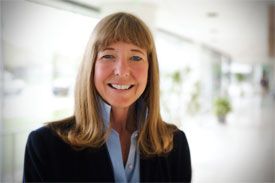
Candace Johnson, PhD
RPCI Deputy Director Candace Johnson, PhD, attributed the center’s success in translating novel therapies from the lab to clinical practice to a number of factors. She explained that the center enjoys the dual benefit of being a freestanding facility with several affiliate sites, while also reaping the rewards of active, long-term collaborative relationships with the University at Buffalo, the Hauptman- Woodward Medical Research Institute, and numerous national and international entities. The result, she said, is a “seamless sharing of resources and talent,” the fruits of which are translated into real-world applications, such as several biotech spin-off companies that form strategic partnerships with investigators and cancer centers worldwide.
The foundation of RPCI’s research and clinical programs is a state-of-the-art campus with laboratory research, educational, and patient care facilities (both inpatient and ambulatory). With the 2006 opening of the RPCI Center for Genetics and Pharmacology—one of the nation’s few Leadership in Energy and Environmental Design-certified research facilities—more than 400 faculty, staff, and graduate students are afforded access to the latest in laboratory technology and design. RPCI’s new on-site Clinical Research Center houses the institute’s investigator-initiated phase I clinical research program, where patients can be specially monitored during ambulatory administration of new cancer therapies.
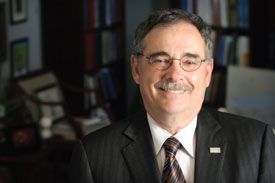
Donald L. Trump, MD
Among the newest and most exciting research focal points is RPCI’s recently expanded drug discovery effort. “The focus is on working to establish new paradigms for novel agents,” said Johnson, “and the key is our ability to employ an innovative approach to genetics in cancer research: namely, identifying the unique genetic signatures of specific tumors and applying that information to our drug discovery efforts.”
“Our founder... articulated what is now understood as the underlying philosophy of modern comprehensive cancer centers: namely, the critical need to bring together multidisciplinary teams of scientists and clinicians to develop an understanding of cancer and to translate that understanding from the laboratory to clinical practice.”
—Donald L. Trump, MD
Such efforts, which represent a significant move toward highly individualized treatment, can take 1 of 2 forms. “We can discover a new cancer/tumor target and then synthesize a new drug that will be effective against that target,” Johnson explained. “Or we can screen any or all of the thousands of existing drugs to identify agents that might have efficacy against that new tumor target.” She went on to note that the basic science conducted at RPCI can then be funneled through the biotech spinoff companies to expedite the transition from bench to bedside.
The institute’s immunotherapy program serves as an example of this multifaceted approach to research. “We’re looking at the immune system in the hopes of identifying areas we can exploit via antibodies,” said Johnson. These investigations will bring together studies in immunotherapy and classic small-molecule drug development to tackle problems related not only to cancer therapy but also to prevention.
On the surgical front, RPCI clinicians are making strides toward providing patients with more precise, less invasive surgical options. The RPCI robotic program serves as a prime example.
Roswell Park Comprehensive Cancer Center Timeline Continued
2000
2010
1886 — RPCI establishes one of the nation’s first long-term survivors’ clinics for childhood cancer patients.
1990-2003— RPCI is a member of the international team of scientists that produces the landmark studies of the Human Genome Project.
2005— Dr Khurshid Guru is appointed director of RPCI’s Center for Robotic Surgery.
2006— RPCI opens the Center for Genetics and Pharmacology.
2008— RPCI’s Clinical Research Center opens.
2010— RPCI opens its Center for Immunotherapy.
Roswell Robotics
RPCI’s reputation as a center of excellence for robot-assisted surgery is known internationally. In 2004 the center became the first in western New York to offer state-of-the-art robot-assisted surgery to prostate cancer patients. Only one year later, RPCI surgeons performed their last open prostatectomies.
Cancer Center Support Grant
Six major National Cancer Institute—funded programs form the basis for Roswell Park Cancer Institute’s Cancer Center Support Grant:
- Cell Stress and Biophysical Therapies Program
- Drug Development and Experimental Therapeutics Program
- Genitourinary Program
- Molecular Epidemiology and Functional Genomics
- Tobacco-Induced Aerodigestive Cancers
- Tumor Immunology and Immunotherapy Program
Through the RPCI Graduate Division of the University at Buffalo, RPCI offers an interdisciplinary Master of Science program, as well as doctoral programs in the areas of cancer pathology and prevention, cellular and molecular biology, immunology, molecular and cellular biophysics and biochemistry, and molecular pharmacology and cancer therapeutics. More than 250 clinical residents, oncology fellows, and visiting MDs are trained through these programs every year, in addition to approximately 70 postdoctoral research fellows and 165 predoctoral graduate students.
In less than 3 years, the percentage of kidney, bladder, and prostate cancer surgeries performed with robotics increased from 50% to 95%; RPCI surgeons now have more than 1500 such procedures to their credit. Particularly noteworthy has been the leadership of Khurshid Guru, MD, associate professor of Urologic Surgery and Oncology, in developing one of the world’s first programs in robot-assisted cystectomies. Guru has performed more than 200 such procedures since 2005 and, today, nearly all cystectomies performed at RPCI are robot-assisted.
The hub of RPCI’s burgeoning robotic surgery program is its Center for Robotic Surgery, equipped with 2 state-of-the-art da Vinci robotic systems and an adjoining teaching laboratory (see “The Nuts and Bolts of Robot-Assisted Surgery”). According to Guru, the Center for Robotic Surgery’s director, it is what happens in the teaching laboratory that sets Roswell apart from other centers that offer robot-assisted surgery.
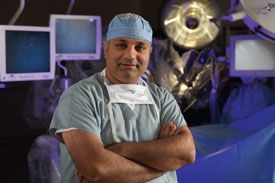
Khurshid Guru, MD
Targeting the Learning Curve
Trump described RPCI’s 2005 recruitment of Guru as a huge step forward for the RPCI. “As one of the world’s first clinicians to develop a technique to remove the bladder and construct the urinary diversion robotically, Dr Guru has performed more of these cystectomy procedures than anyone in the world and has pioneered several advanced robotassisted techniques,” said Trump.
But while most people are eager to tout the high-tech capabilities of robot-assisted surgery, “they rarely address one of its major limitations: a very sharp learning curve,” said Guru, noting that dangerous errors can and do occur without proper training.
Guru and his colleagues wasted no time taking their place at the forefront of training for robotassisted surgery and now lead a worldwide consortium for developing these training programs. RPCI is, in fact, one of the first centers to have developed a robotic curriculum, has created the world’s first virtual robotic training and research program, and is the first center to develop a video- based textbook on robotic surgery.
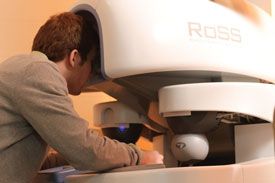
The Nuts and Bolts of Robot-Assisted Surgery
From her seat at a console, a surgeon operates the controls that guide a robot’s 4 arms, designed to mimic the movements of conventional surgery, but with slim robotic arms and wrists that swivel 360 degrees. As the robotic arms grasp a camera and surgical instruments that are inserted into the body through small keyhole incisions, the system provides her with a 10x magnified view of the operating field. The instruments move easily and precisely through tight spaces while eliminating any normal hand tremor.
Robot-assisted surgery combines the skill, experience, and judgment of the surgeon with the superhuman flexibility and precision of robotic and computer technology, eliminating limitations and barriers such as those imposed by hand size, degree of dexterity, and visual restrictions.
Patients consistently report high satisfaction with robot-assisted procedures, reaping the benefits of smaller incisions, less blood loss, and less pain than that experienced with open surgery, and, importantly, shorter hospital stays and faster recovery times.
Surgeons come to RPCI’s Center for Robotics from around the world to participate in 16 hours of hands-on training on the robotic surgical simulator (RoSS), developed at RPCI. “Dr Guru partnered with the scientists at the University of Buffalo’s biomedical engineering department to produce exact clinical fields that create realistic intraoperative experiences, including complications,” said Trump. “He then went on to found a company to produce the software that controls the robot.”
RPCI’s training center is funded by 4 foundations and investigators are now beginning to assess the results of such training, as well as the potential benefits of being able to “warm up” on the simulator before operating on patients. “The technology is improving and the applications are expanding to gynecologic, colorectal, thoracic, and head/neck cancers, as well as some noncancerous conditions,” said Guru. “But allowing the technology to ‘outrun’ the training will be like letting the tail wag the dog,” he cautioned.
Small but Mighty: A Culture of Excellence
The RPCI timeline of milestones, as described on the preceding pages, is perhaps even more impressive in light of the center’s relatively small size (see “Roswell Park Statistics”), something Trump views as an asset. “Our scientists pass our clinicians in the hallways and see our patients and their families in the cafeteria every day,” he said. “This proximity and these interactions have been the norm at Roswell Park [Cancer Institute] for 113 years, and serve as constant reminders of our clinical mission.”
Trump noted that both patients and staff benefit from RPCI’s culture of excellence. In 2010, for example, RPCI was ranked 33rd in the “Best Hospitals—Cancer” list put out by US News & World Report, was named a Leapfrog Top Hospital for patient safety and outcomes, was designated a Magnet Recognition Program facility by the American Nurses Credentialing Center, and was cited as one of the “Best Places to Work in Academia” by The Scientist magazine. The Scientist again recognized RPCI in early 2011, naming it one of the best places to work for postdoctoral researchers.
“The workplace honors mean a great deal to me,” said Trump. “We do our best to understand what makes the workplace challenging and what we can do to improve our employees’ quality of life. After all, what benefits our employees ultimately benefits our patients and their loved ones.”
Roswell Park Statistics
- Beds: 133
- New patients seen each year: 8200
- Annual outpatient visits: 200,200
- Physicians and senior scientists on staff: 267
- Postdoctoral research fellows: 70
- Predoctoral graduate students: 164
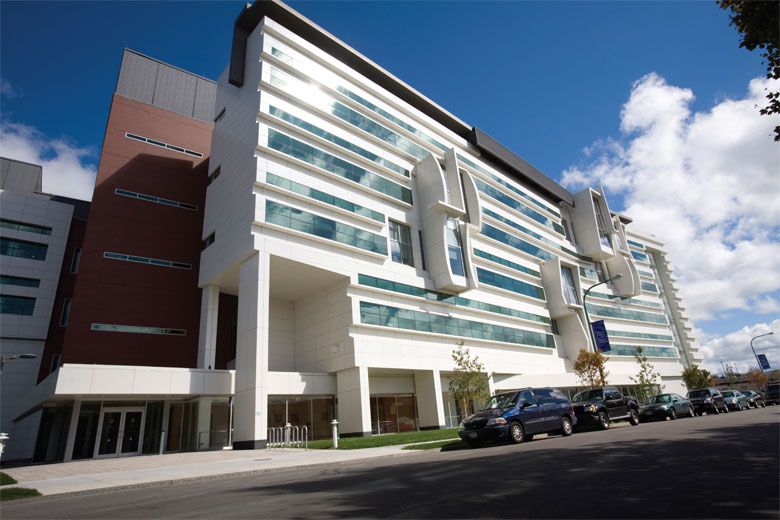
Laura Bruck is a Cleveland, Ohio-based freelance writer and editor who has specialized in healthcare reporting since 1987.
